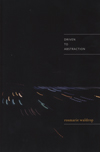Driven to Abstraction
Waldrop, co-founder and publisher of Burning Deck Books, an extraordinary translator, and an accomplished poet whose work I have always found utterly breathtaking, just keeps getting better. I admire Waldrop’s lyrical stamina—she sustains long series of related poems with impeccable control over every syllable, there is nothing superfluous, careless, or casual—and her ability to ground the abstract and abstract from the grounded, from the world of objects and circumstances (driven, as she is, to abstraction).
The book contains two series of poems, “Sway-Backed Powerlines (2004-2008)” and “Driven to Abstraction.” The first consists of four sections, each composed, in turn of a long series of numbered or named prose poems, the last group of which also include a secondary component of a dictionary of related words (a to z ) in small type at the foot of the page. The last word in “Sway-Backed Powerlines” is “zero,” which becomes the central preoccupation of the latter half of the book and, in fact, the final page of the book concludes:
ZERO,
OR, CLOSING POSITION
Contradict as needed
“Driven to Abstraction” is also composed of series of like-formed segments (long lyrical lines in short bursts, long prose-poem like lines in short blocks). This form gives them a sense of unity and wholeness that is useful, but it is not what is most important, I don’t think, about the work in this book.
Like most (if not all) of Waldrop’s work, this book is a long query into the meaning of meaning, into the power of language and the language of numbers. These poems ask us to consider what it means to “discover” and claim a country (“The power to name is power. Especially when backed by guns”); to stake a claim on history (“Great beginnings too can end up a small world”); to ponder our fathers’ biographies (“Does this fit my image of the real?”); to consider the art of self-reflection (“Vermeer paints himself painting”); and to consider the grammar of mysticism (“I am that I am” she quotes the Old Testament).
If you are tempted to imagine, however, that Driven to Abstraction is simply an exercise in linguistic play or manipulation, let me assure you, it is not. “Unless we recognize a language we do not recognize a man. We wrap entire villages in barbed wire,” the poet tells us. And a few pages later:
4,000 to 6,000 civilians have been killed in Fallujah.
It is impossible to describe the fact which corresponds to this sentence, without simply repeating this sentence.
When, later, Waldrop ponders the meaning of zero, the nature of counting, the relationship of nothing to writing and of writing to emptiness, emptiness to knowledge, she is not asking rhetorical questions. She is not merely enjoying a linguistic game. She has already given us those 6,000 (dead) civilians.
King Lear, she tells us, was “thrilled by quantity as language.” But, Waldrop has “made a pact with nothingness.” She knows we cannot be redeemed (“If there is no redemption by voice”). She is—we are all of us—implicated in the countries we name/claim as our own, in the bodies, counted and uncounted, in zero’s failure and in its power. And yet, “at the bottom of anything I find a word that made it.” We are not empty, after all. Language is everything.
I adore this book and continue to think that Waldrop is an incredibly gifted poet whose language about language is, in so many ways, the most important writing we can read. Contradict as needed—but, you’ll have to use language to do it.





